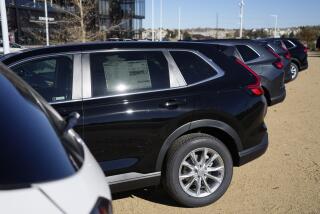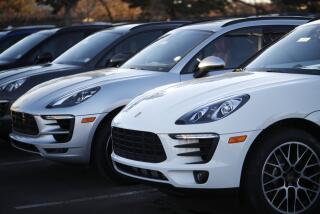Car Incentives Set a Record
Automakers set a U.S. sales record in July, but it cost them plenty: a record $5.34 billion in incentives.
That’s $2,981 per vehicle to move all that metal, up 3% from a year earlier and an increase of nearly 5% from incentive spending in June, Edmunds.com, an automotive market information provider, reported Thursday.
The run-up was the result of the popular “employee discount” plans, which were offered for the first time last month to the public by all three U.S. carmakers. Foreign manufacturers increased their discounting to remain competitive, analysts said. In all, nearly 1.81 million passenger vehicles were sold in July.
That could spell trouble for General Motors Corp. and Ford Motor Co. and their hopes of cutting back on incentives.
The two companies said this week that they would be cutting sticker prices and increasing the number and types of features on many 2006 models in hopes of weaning consumers off big rebates and other incentives.
But Jesse Toprak, senior analyst at Santa Monica-based Edmunds, said the strategy might not work.
“The transition to lower sticker prices is going to be a sticky one,” he said. “People are used to incentives and are still going to want to know where their $5,000 or $8,000 discount is.”
The monthly incentive spending tallied by Edmunds includes the cost of the employee discount plans offered by U.S. makers as well as the rebates, discounts and low-interest and cut-rate leasing plans offered by many importers.
Chrysler lowered sticker prices on its Dodge Durango sport utility in 2004 and on its family of minivans this year. But competition has forced it to increase incentives on the vehicles to the same levels they were at before the prices were lowered, Toprak said.
Automakers would have to provide “believable before-and-after price stickers if they hope to persuade potential buyers they can get a good deal without big incentives,” said Wes Brown, an auto industry analyst at Iceology, a Los Angeles market research firm. July’s blistering incentive spree didn’t guarantee car buyers the best deals ever. Chrysler and GM actually cut monthly average incentive spending: Chrysler by $73 to $3,623 per vehicle and GM by $56 to $4,135.
Ford buyers, however, probably did well for themselves: the company upped its incentive spending by an average of $688 per vehicle, to $3,876, in order to remain competitive.
The biggest single incentive package, worth $11,253, was on Cadillac’s 2005 DeVille model. On the other end of the scale, a handful of vehicles including Chrysler’s Crossfire sports car and eight high-performance Mercedes-Benz models sold with no incentives.
Edmunds said that big sport utility vehicles continued to need the biggest incentives to lure customers wary of their heavy gasoline consumption at a time when fuel prices were hovering near record levels. The industrywide average incentive spending on SUVs in July was $5,164 per vehicle.
Spending by the three U.S. carmakers averaged $3,942 per vehicle, an increase of $113 from June, all attributable to Ford, which began its discount plan in July.
European automaker spending averaged $2,382 per vehicle, up $447 from June; Korean carmakers were up $99 to an average of $1,945; and Japanese automakers spent an average of $1,236, the industry’s low, although still $198 per vehicle more than they spent in June.
Overall, U.S. automakers’ spending accounted for 80.6% of the incentives in July, or $4.3 billion; Japanese manufacturers spent $653 million, or 12.2%; European carmakers, $245 million, or 4.6%; and Korean manufacturers, $137 million, or 2.6%.
GM, which began the present round of price wars in 2001 and upped the ante in June when it launched the first of the employee discount pricing plans, continued to lead the major automakers with incentive spending. Its Saab unit was the industry’s big spender at an average of $5,523 for each car its dealers sold. German performance car maker Porsche spent the least: $157 per vehicle sold.
Among the individual makes of cars, BMW’s Mini spent the least on incentives, with an average of $28 per vehicle, while GM’s Cadillac spent the most, $6,442.
*
(BEGIN TEXT OF INFOBOX)
Deals on wheels
Here are the vehicles offering the highest sales incentives in July.
*--* Model Incentive Cadillac DeVille $11,253 Jaguar XKR 8,855 Volvo S80 8,637 Saab 9-5 7,823 Cadillac Escalade ESV 7,760 Jaguar S-Type R 7,615 Cadillac SRX 7,444 Volvo XC70 7,443 Cadillac Escalade 7,417 Cadillac Escalade EXT 7,131
*--*
Source: Edmunds.com
*
(BEGIN TEXT OF INFOBOX)
Cost of sales
Here are the average sales incentives offered by the top automakers in July.
*--* Average Automaker incentive General Motors $4,135 Ford 3,876 Chrysler 3,623 Volkswagen 2,299 Nissan 1,948 Hyundai 1,945 Toyota 1,001 Honda 942
*--*
Source: Edmunds.com
More to Read
Inside the business of entertainment
The Wide Shot brings you news, analysis and insights on everything from streaming wars to production — and what it all means for the future.
You may occasionally receive promotional content from the Los Angeles Times.










